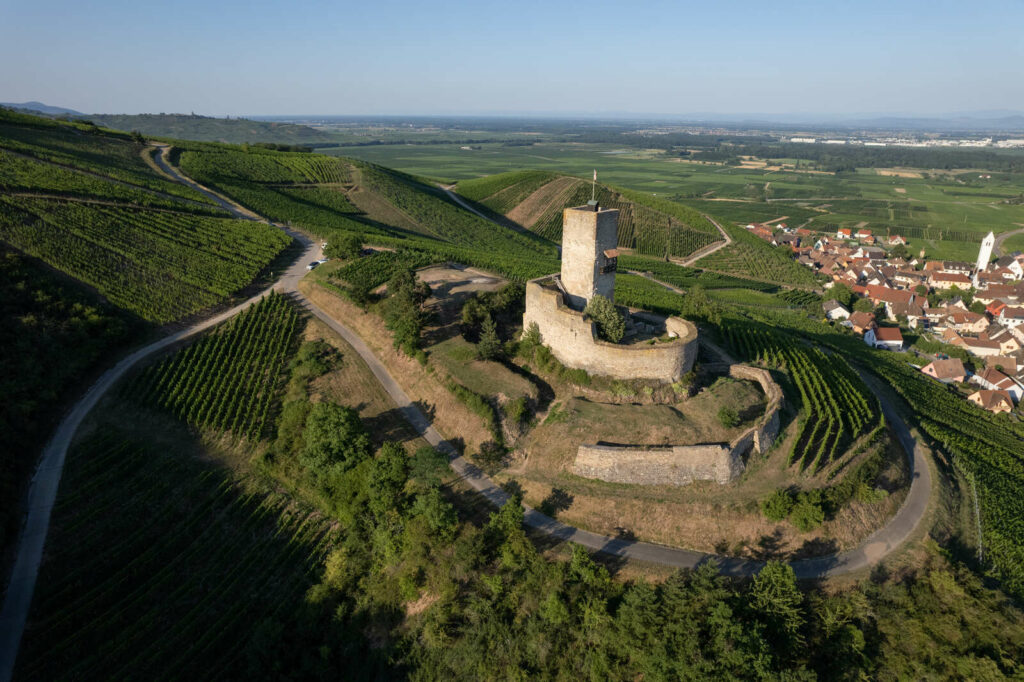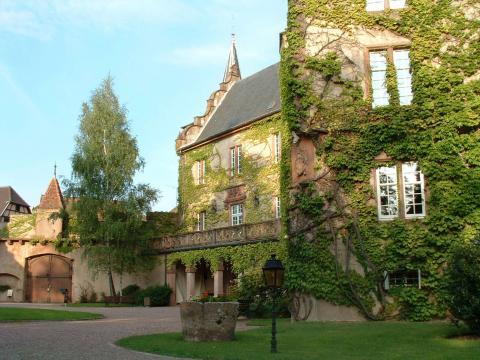Dive into the history of Alsatian castles
Alsace is a land steeped in history, with centuries of trade, art, civilisation and conflict… Witnesses of this extraordinary past, many castles and fortified towns from different periods have survived the ages and still remind us of this illustrious history today
The Kaysersberg valley also has many fortified structures that dot its landscapes, both in the vineyards and in the mountains.
The Wineck castle overlooking Katzenthal
Located in the small town of Katzenthal, the Wineck castle is the only Alsatian castle to be surrounded by vines, which perhaps explains its name (wineck – wine corner).
Built in 1200 on a granite spur overlooking the village, it has a 21-metre square keep used as a dwelling.
Owned by the Counts of Eguisheim-Dabo and then the Count of Ferrette, the Wineck castle became the property of the Barons of Rathsamhausen in the 14th century. They enlarged it and added an additional wall to protect themselves from possible attacks.
Destroyed by fire in the 15th century, the abandoned castle fell into ruin.
In 1972, the Friends of Wineck Association restored the castle and gave it a new lease of life.
The association also offers tours: every Sunday afternoon and public holidays, from the first Sunday in April to All Saints’ Day, from 2 to 6 pm.
Outside these times, a visit (for groups in particular) is always possible. Contact Mr Laengy Pierre (president of the association) by e-mail pierre.Laengy@gmail.com or by phone: 03 89 47 85 63.

Kaysersberg Castle, overlooking the imperial city
In 1227 the imperial provost Woelflin, on behalf of Frederick II of the Holy German Empire, had the castle of Kaysersberg built on a rocky promontory in order to control an important passageway between Upper Alsace and Lorraine.
Of late Romanesque architecture, the castle was linked to the town by a solid urban rampart. Flanked by a powerful circular keep of 4m which served as an observation post, the castle of Kaysersberg will charm you with its magnificent panorama.
The defensive role of the castle declined with the prosperity and autonomy of Kaysersberg.
However, during the Thirty Years’ War (1618-1648), the castle, its dwelling and annex buildings were burnt down and left to deteriorate. Restored in the 19th century, it was classified as a historical monument in 1841.
A must-see when visiting Kaysersberg, its silhouette is now the emblem of the imperial city.

The Hohnack castle on the heights of Labaroche
Nestled in a green setting, the Hohnack castle watches over the peaceful mountain commune of Labaroche. Located at the junction of the Kaysersberg and Munster valleys, it rises to an altitude of 927m. The name Hohnack comes from “Hohen Acker”, the upper field. Traces of protohistoric occupation and a probable Roman lookout post seem to confirm that the strategic position of this high plateau was known for a long time.
Built around the 12th century, the Hohnack castle consisted of a polygonal enclosure of humped stones, a square keep and a seigneurial dwelling. It quickly acquired the reputation of being an impregnable fortress.
The lords of Ribeaupierre de Ribeauvillé, who owned it, hid their precious goods there during the troubled times of the Thirty Years’ War.
However, in 1635 the troops of the King of France, Louis XIII, seized it by deception and garrisoned it until 1654.
Demolished in 1655 on the orders of Louis XIV to prevent it from being used as a military base, the Hohnack castle was used as a quarry for local construction. Now owned by the commune of Labaroche, it is maintained and restored with passion by the association “Les Compagnons du Hohnack”. During its restoration, the old fortress is only revealed to the volunteers of the association who are working to get it back into shape. However, even from the outside, the castle remains imposing and is well worth a look.

Schwendi Castle, of the Brotherhood of St. Stephen in the heart of the vineyards of Kientzheim
Of the original construction dating from the 15th century, undertaken by John I of Lupfen, only the vaulted cellar of the west wing and perhaps part of the structural work remain. Indeed, when Lazare de Schwendi, a military man and discoverer of the Hungarian Tokay grape variety, acquired the castle around 1563, he enlarged and partially rebuilt it, giving it its current Renaissance style.
The castle remained in the Schwendi family until 1770. Then, throughout the 19th century, several owners succeeded each other, each carrying out different works. The south-west tower and a beautiful outdoor terrace were added to the castle. The land was also levelled, leaving room for a magnificent garden.
The castle became the property of the Confrérie Saint-Étienne in 1972, which had the premises restored and fitted out for its activities. In 1980, the museum of the vineyard and wines of Alsace was installed in the old outbuildings.
